Ever tried to catch raindrops in your garden? Well, I did—as if I were some rain-loving superhero!
I set up barrels everywhere, convinced they’d hold more water than my small-town pool. Spoiler alert: they didn’t exactly fill up like I hoped! I mean, who knew that filtering rainwater could be a full-time job?
Then, I tossed in a rain garden. Planted Echinacea purpurea, like a pro gardener, to manage stormwater and boost biodiversity. Did I fix everything? Not quite. But hey, every drop counts!
Are you ready to embrace your inner eco-warrior?
Designing a Rainy Day Haven: My Garden Adventure
Last summer, I learned the hard way that not all plants handle stormy weather gracefully. I planted a whole bunch of native species, and honestly, my backyard turned into a mini swamp. I pondered if Mother Nature was flexing on me!
After a few sun-drenched days, I redesigned the layout—added strategic elevation and curved paths for better drainage. Who knew a little slope could make such a difference? Now, my garden is not just a rain catcher, but also the envy of the neighborhood! With the right design tweaks and plant choices, you can create your own water-loving sanctuary too. Don’t let the rain get you down; let it nourish your dreams!
Quick Takeaways
- Implement a rainwater harvesting system to capture thousands of liters of water for garden nourishment.
- Utilize quality filters and first flush diverters to maintain the purity of harvested rainwater.
- Design rain gardens to absorb stormwater runoff and reduce flooding risks by incorporating native plants.
- Ensure proper soil management techniques, like aeration and contouring, to enhance water retention and drainage.
- Analyze local rainfall data to inform collection strategies and maximize water capture tailored to seasonal variations.
Understanding Rainwater Harvesting Systems

Have you ever wondered how to make the most of those precious raindrops that fall upon our gardens?
Implementing a rainwater harvesting system isn’t just a smart choice; it’s an empowering act for any gardener.
Harvesting rainwater is not merely practical; it’s a transformative experience that enriches both your garden and your soul.
Picture large barrels, like those from Rain Barrel Depot, strategically placed beneath your downspouts, enthusiastically awaiting each rainfall. These systems can capture thousands of liters of water, nourishing your prized plants, including robust Hydrangea macrophylla or vibrant Salvia nemorosa.
By investing in quality filters and a first flush diverter, you guarantee the purity of your harvested water, essential for healthily sustaining a thriving ecosystem.
Additionally, these systems can be coupled with smart visual strategies to optimize water distribution throughout your garden.
Empower your environment through efficient water management—transforming those fleeting droplets into a sustainable masterpiece can enhance not just your garden’s beauty, but your connection to nature.
The Role of Rain Gardens in Stormwater Management

A rain garden serves as a stunning and functional addition to any environment, effectively managing stormwater runoff while nurturing biodiversity.
By strategically planting species such as Asclepias tuberosa, Rudbeckia hirta, and Echinacea purpurea, I’ve found that these native plants not only absorb rainwater but also attract beneficial pollinators.
The design promotes infiltration, reducing erosion and flooding risks; it harnesses the potential of greywater, empowering us to reclaim nature’s resources.
Incorporating an aesthetically pleasing combination of textures and colors can enhance both utility and beauty.
Moreover, implementing native desert landscaping strategies can further support local wildlife and decrease water usage in arid environments.
My experiences with rain gardens highlight their significant role in stormwater management, transforming mere terrains into essential ecosystems.
This motivates my passion for sustainable gardening and inspired the creation of Botanical Mood, where beauty and functionality coexist.
Techniques for Effective Soil and Earthwork

While designing a beautiful garden requires an eye for aesthetics, it’s equally essential to focus on effective soil and earthwork techniques that support the intended growth of plants. The right techniques guarantee your plants thrive, utilizing space efficiently, and maximizing water retention.
| Technique | Description |
|---|---|
| Soil Aeration | Enhances root access to oxygen |
| Amendments | Improves nutrient availability |
| Contouring | Directs water flow strategically |
| Layering | Creates a rich, structured base |
When I explore designs for Botanical Mood, I guarantee that soil selection, like loam (Lorum), is balanced for moisture retention. A strong foundation leads to resilient ecosystems, inviting beauty and harmony in every corner of your garden.
Calculating Water Volume for Harvesting Efforts

Calculating water volume for harvesting efforts plays an essential part in guaranteeing that your garden flourishes, particularly in regions where rainfall can be sporadic.
By precisely measuring the expected precipitation and understanding the capacity of your rain barrels or cisterns, you’ll empower your garden to thrive even during dry spells.
For instance, knowing that an inch of rain falling on 1,000 square feet yields about 600 gallons allows you to strategize your collection systems effectively.
Utilizing quality rainwater management systems, like those from Rain Harvesting or Aqua-Dynamic, guarantees you capture every precious drop.
Additionally, you can maximize your efforts by analyzing local rainfall data, thereby adapting your approach for different seasons, ultimately creating a resilient and life-sustaining haven in your environment.
Selecting Ideal Plant Species for Rain Gardens
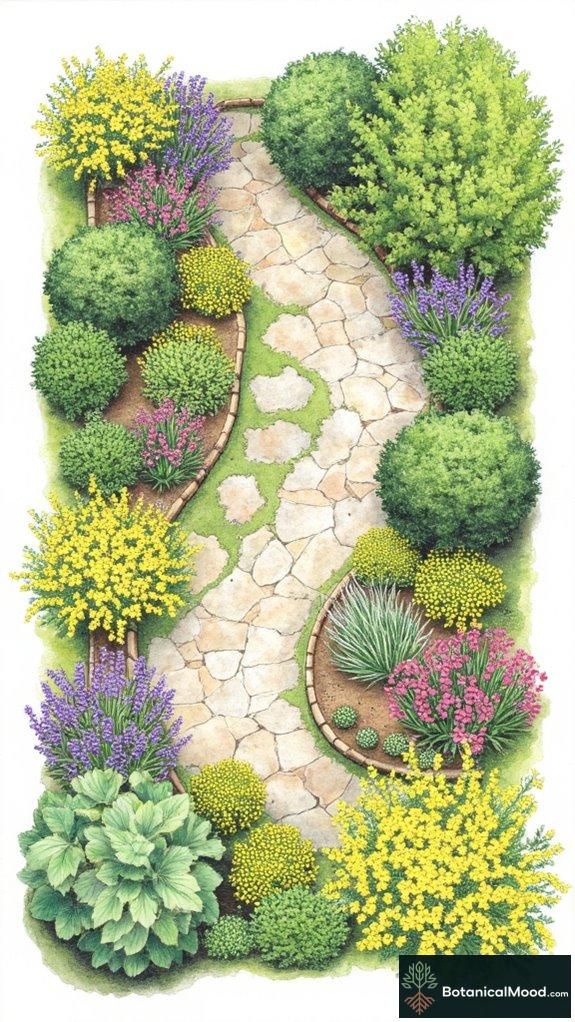
When designing a rain garden, selecting the perfect plant species is essential for ensuring ideal water absorption and aesthetic appeal.
I prefer using native plants like Echinacea purpurea (purple coneflower) and Rudbeckia hirta (black-eyed Susan), which thrive in wet conditions and attract pollinators. These species not only enhance biodiversity, but they also provide vibrant colors, transforming a functional garden into an oasis.
Furthermore, incorporating shrubs such as Ilex verticillata (winterberry holly) offers structure while improving flood resilience.
Incorporating shrubs like Ilex verticillata enhances garden structure and boosts flood resilience.
Combining varying heights and foliage textures, I like balancing taller plants with low-growing groundcovers like Carex pensylvanica (Pennsylvania sedge) for visual interest.
Through selecting the right plant species, I create a beautiful, sustainable design that captures every valuable raindrop while contributing to the environment, reflecting my mission with Botanical Mood.
Integrating Infrastructure and Aesthetics
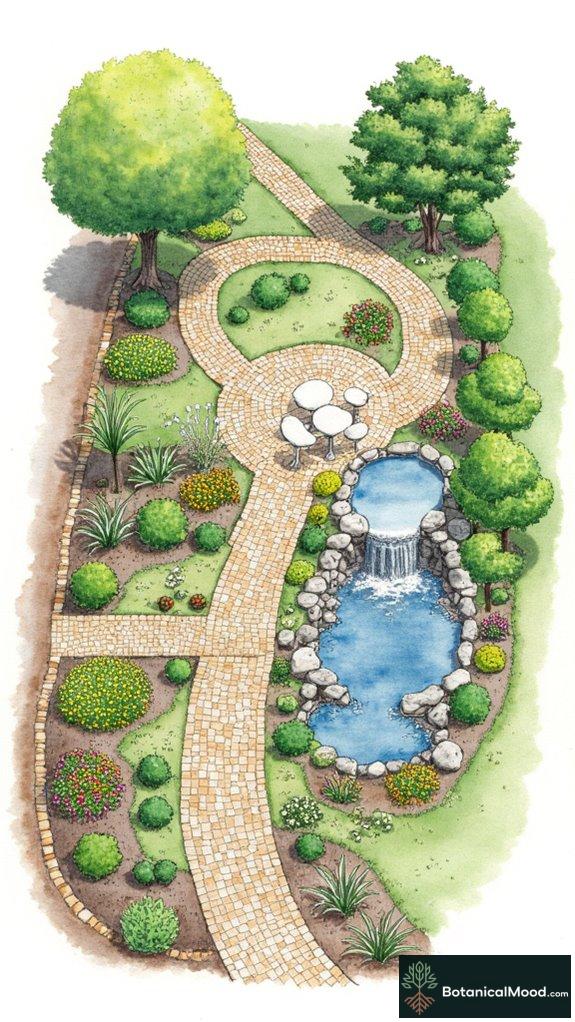
Integrating infrastructure with aesthetics in rain gardens not only enhances their functionality but also elevates their visual appeal, creating a harmonious blend of nature and design. When I approach this fusion, I consider the interplay of elements like permeable pavers, cascading water features, and strategically placed native plants (such as Rudbeckia hirta) that thrive in these environments.
| Element | Functionality | Aesthetic Appeal |
|---|---|---|
| Permeable Pavers | Facilitate drainage | Introduce texture |
| Native Plants | Promote biodiversity | Add vibrant colors |
| Stone Borders | Define space | Create visual interest |
Sustainable Practices for Long-Term Water Conservation
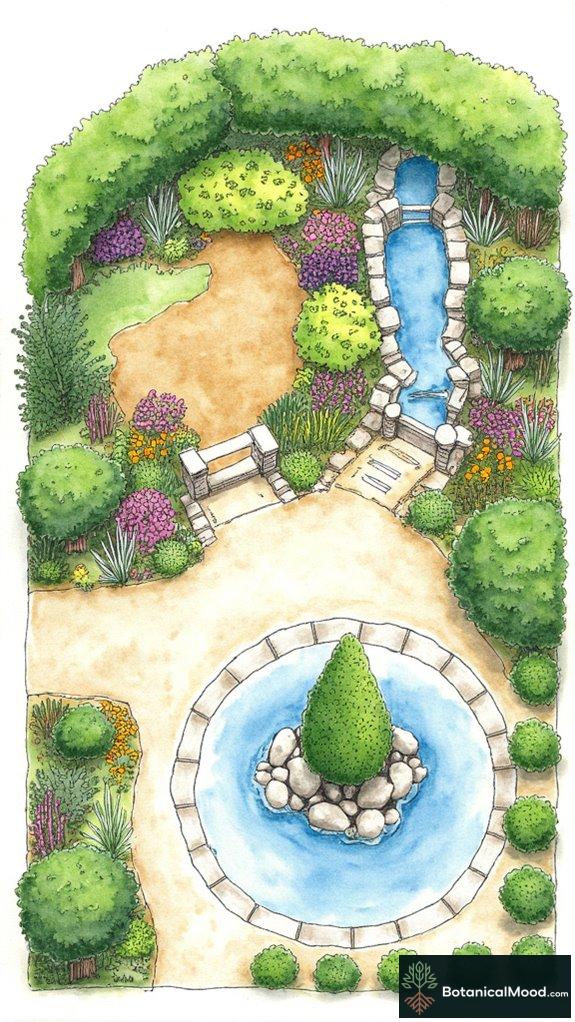
While aiming for a sustainable garden that conserves water without sacrificing beauty, I’ve discovered some effective practices that don’t just save resources but also enhance the overall scenery.
Implementing xeriscaping principles allows me to choose drought-tolerant plants like Lavandula angustifolia (English Lavender) and Salvia officinalis (Common Sage), which thrive in minimal water.
Embracing xeriscaping lets me select resilient, drought-tolerant plants like English Lavender and Common Sage, flourishing with minimal water.
Installing a rain garden not only captures stormwater but also nurtures local biodiversity, attracting pollinators with vibrant colors.
Incorporating mulch, like shredded bark or straw, retains soil moisture while adding texture and depth.
I’ve also invested in drip irrigation systems, ensuring precise water delivery to plant roots, reducing waste effectively.
With these powerful practices, I’m crafting a lush, resilient garden that exemplifies both beauty and sustainability, reflecting the ethos behind my Botanical Mood vision.
Essential Components of a Rainwater Harvesting System

When it comes to creating an effective rainwater harvesting system, there are seven essential components that I believe every garden enthusiast should consider.
First, storage tanks need to be durable, ideally made from UV-resistant materials. Next, filtration systems must be chosen to eliminate debris, ensuring clean water.
Durable, UV-resistant storage tanks and effective filtration systems are key to ensuring clean rainwater for your garden.
Furthermore, gutter extensions can direct rain efficiently into these tanks.
Overflow mechanisms should be designed to manage excess water, while regular maintenance practices are vital for longevity.
Don’t overlook legal considerations regarding water collection, as they vary by region.
Finally, understand the system costs and installation techniques, as this can greatly affect your garden’s sustainability.
Techniques for Efficient Rainwater Catchment

To maximize your garden’s potential in capturing rainwater, it’s essential to implement creative techniques that enhance efficiency and effectiveness.
I like to utilize innovative catchment techniques, such as installing rain barrels (e.g., Fiskars or RainReserve) beneath downspouts to redirect flows, consequently ensuring every drop finds a purposeful home.
Furthermore, employing permeable paving materials allows rainwater to seep directly into the ground, minimizing runoff.
I also opt for diverse storage solutions, like underground cisterns, which neatly accommodate rainfall while maintaining an uncluttered environment.
Designing Functional Rain Gardens

Designing a functional rain garden not only benefits the environment by managing stormwater runoff, but it also adds a stunning focal point to your outdoor environment.
When tackling rain garden design, I prioritize native plant selection, as these species thrive in local conditions and attract beneficial wildlife. Consider incorporating plants like Echinacea purpurea (Purple Coneflower) or Rudbeckia hirta (Black-eyed Susan), which flourish in diverse climates while offering vibrant blooms.
Additionally, incorporating nectar plants for pollinators can further enhance biodiversity and attract butterflies and bees to your garden. The thoughtful arrangement of colors and heights creates visual interest. By intentionally curating these elements, I not only enhance my setting but also contribute to sustainable gardening practices that capture every raindrop effectively.
Maximizing Water Retention With Soil Layering

Creating a robust foundation for your rain garden starts with soil layering, an essential technique that maximizes water retention and promotes healthy plant growth. By incorporating various soil amendments like compost and peat moss, I enhance moisture retention, allowing plants like *Echinacea purpurea* (coneflower) and *Rudbeckia hirta* (black-eyed Susan) to thrive. For best results, I layer coarse gravel at the bottom for drainage, followed by a mix of sandy loam and organic matter. This combination guarantees water is captured effectively while preventing saturation, allowing me to maintain control over my garden’s health and beauty. Furthermore, utilizing native wisdom in selecting plants ensures that my garden becomes a haven for both flora and fauna.
Sustainable Landscaping Practices for Urban Gardens
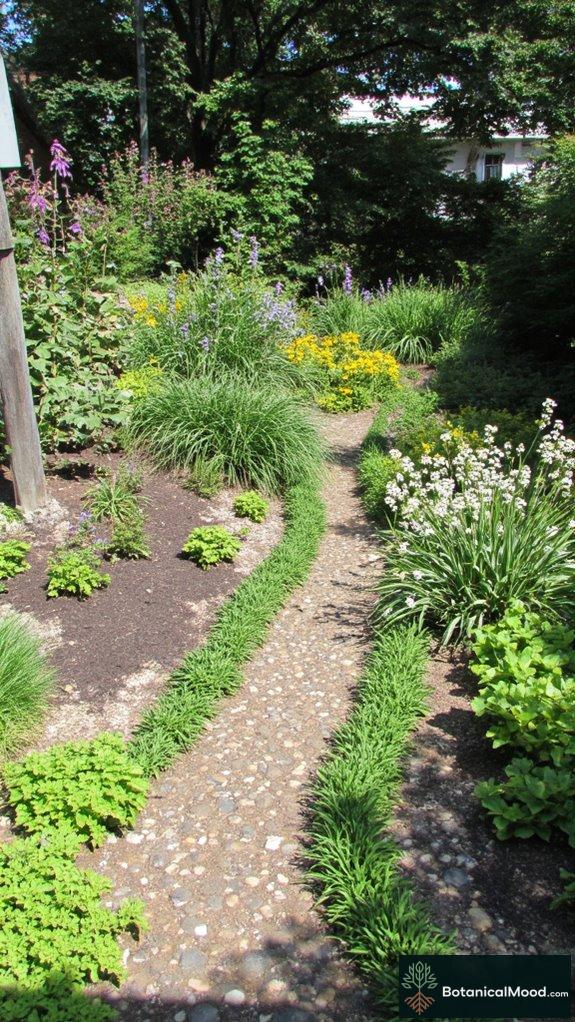
Additionally, using mulches made from organic matter helps retain moisture while providing nutrients as they decompose, achieving a balanced environment where both plants and microorganisms thrive.
Utilizing permaculture principles, I’ve transformed my urban habitat into a lush oasis. By selecting native plants like Echinacea purpurea and Rudbeckia hirta, I support local biodiversity while ensuring easier maintenance.
Transforming urban spaces with native plants nurtures biodiversity and simplifies garden upkeep.
Incorporating rain gardens can effectively capture runoff, enriching soil and fostering resilience against drought. Utilizing permeable pathways and crafted beds harmonizes aesthetics with functionality, creating visually appealing spaces that serve ecological purposes.
Sustainable landscaping lets me manage my garden with confidence and care.
Sustainable Garden Planning
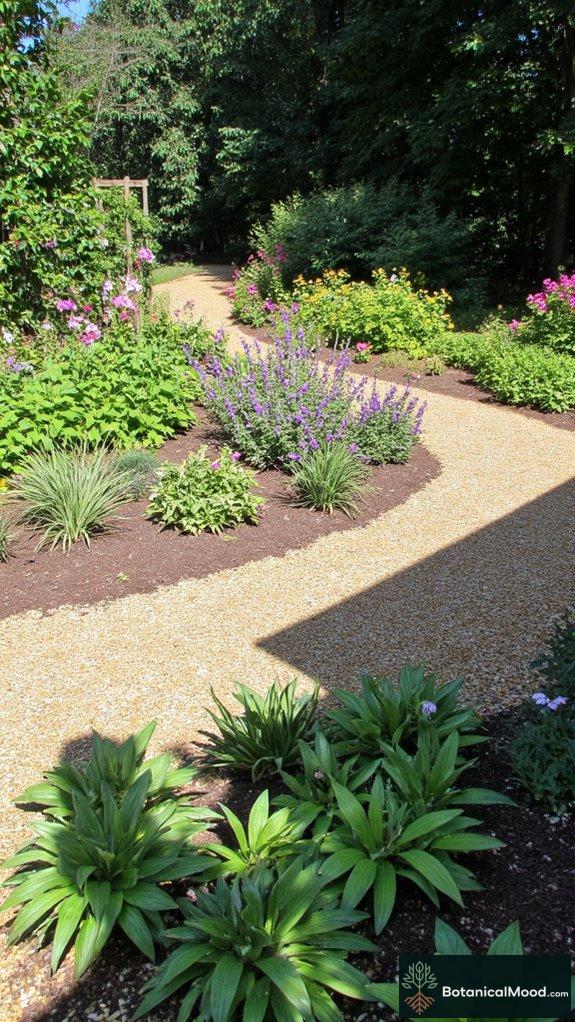
Sustainable garden planning forms the backbone of any eco-friendly scenery, creating a harmonious relationship between nature and design.
I always consider the essential elements—site analysis, soil health, and native flora. Choosing plants like Echinacea purpurea and Rudbeckia hirta not only enhances biodiversity but thrives in local conditions, reducing the need for excessive watering and fertilizers.
Incorporating perennials broadens seasonal color while fostering a sense of stability in design.
Furthermore, employing structures such as trellises can increase vertical space, allowing for an abundance of climbing species like Phaseolus coccineus. Each decision, whether selecting mulch or optimizing irrigation, contributes to a powerful vision of resilience and beauty.
Every detail matters, driving home the purpose I envisioned with Botanical Mood: sustainable beauty in every raindrop, maximizing what nature gifts us.
Rain Garden System Design
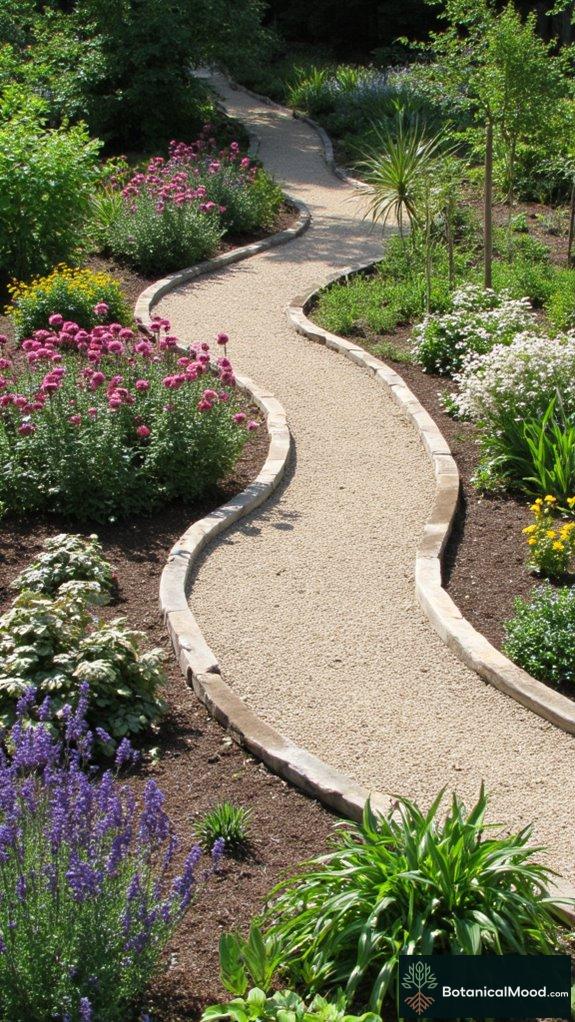
Designing a rain garden is an exercise in marrying function with beauty, where the goal is to create an effective system that harnesses the power of nature while enhancing the overall scenery.
To achieve this, I evaluate soil drainage through color, ribbon, and percolation tests, guaranteeing ideal infiltration and plant health. I meticulously size the garden to capture up to near 100% of runoff from impervious surfaces, incorporating necessary structures like overflow devices to manage excess water.
Selecting deep-rooted native plants, like Echinacea purpurea and Rudbeckia hirta, guarantees stability and biodiversity, while smooth organic shapes elevate aesthetics.
These gardens not only filter pollutants but also harmoniously blend into our environment, empowering each drop of rain to serve a purpose.
Rain Garden Spatial Arrangement
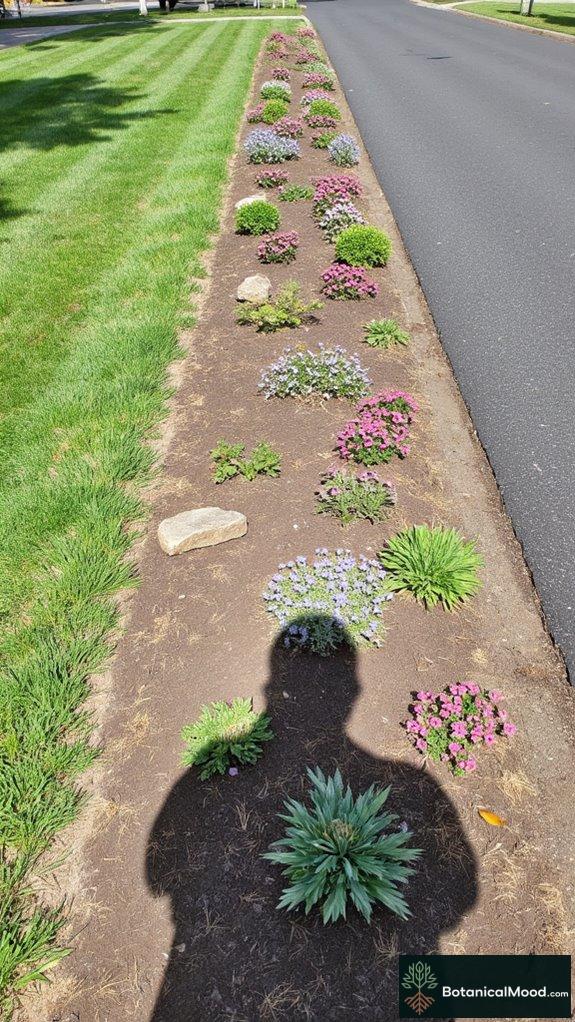
Creating a rain garden requires thoughtful spatial arrangement to guarantee it effectively captures and utilizes stormwater runoff while seamlessly integrating into the surroundings.
Positioning the garden between runoff sources, like roofs or driveways, and destinations, such as storm drains, is essential for maximizing interception. I avoid low-lying spots that remain wet and instead opt for downslopes, ensuring structures like basements aren’t threatened by intruding water.
For an appealing design, I maintain proportionality between garden size and yard area, and I often favor clusters of perennials (like Echinacea purpurea) that offer both aesthetic and functional synergy.
Sustainable Techniques From Local Expert
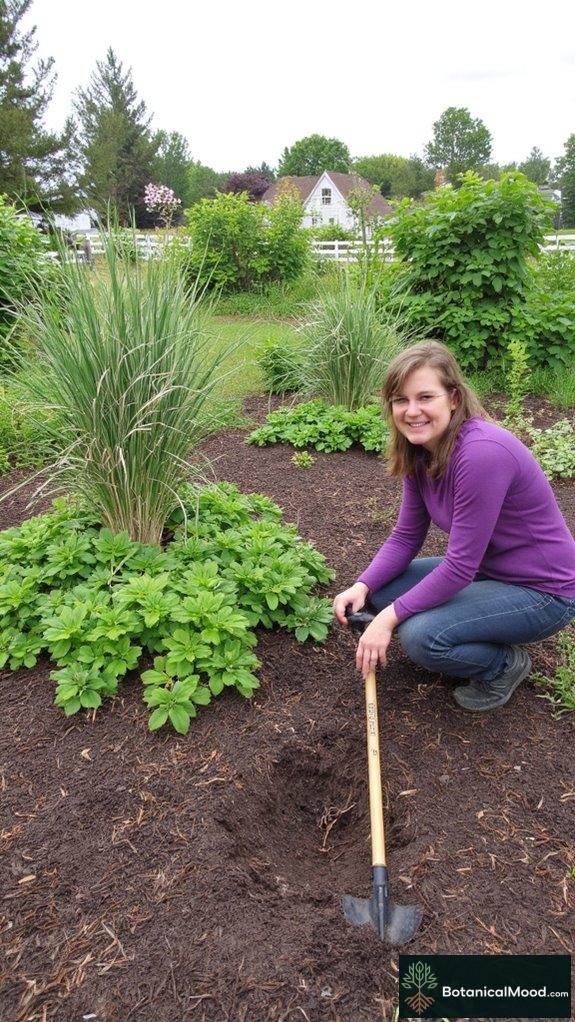
Lindsey Carter from Asheville, North Carolina, envisioned a sustainable garden after witnessing heavy rainfall causing erosion in her neighborhood. This inspired her to create a rain garden that captures and filters stormwater.
To design her rain garden, Lindsey collaborated with local horticulturists and environmental specialists, utilizing a mix of native, deep-rooted plants. She focused on achieving an ideal infiltration rate by preparing the soil with 50% sand, 40% loam topsoil, and mixing in 10% compost.
Using tools from brands like Fiskars for weeding and a shovel from Ames, Lindsey created her garden layout. She incorporated accessories like drain pipes and mulch from Gardener’s Supply Company, ensuring her garden functioned efficiently with nature’s ecosystem in mind.
Top Botanical Gardens Nationwide
Have you ever wondered what makes botanical gardens such essential hubs for biodiversity and education? Across the U.S., we boast a staggering collection of 296 to 1,014 botanical gardens, maintaining about 600,000 living plant accessions representing 40,000 species.
Botanical gardens embody vital centers for biodiversity and education, showcasing thousands of plant species across the U.S.
Longwood Gardens in Pennsylvania captures my attention, spanning 1,100 acres and hosting over 1.6 million visitors annually, while Tucson Botanical Gardens showcases the arid beauty of the Sonoran Desert.
The United States Botanic Garden stands out with its diverse sections, revealing the fascinating world of Nymphaea (water lilies) and Nepenthes (carnivorous plants).
These gardens not only enchant but also educate, proving essential in our collective journey toward conservation—a mission I reflect upon deeply through my efforts at Botanical Mood.
Historic European Botanical Gardens
European botanical gardens have long stood as living demonstrations to the complex relationship between human endeavor and the natural world, reflecting centuries of history, scientific inquiry, and aesthetic beauty.
These historic spaces, rich in botanical significance, showcase plant diversity and research that have evolved through varied historical circumstances.
- Leipzig Botanical Garden (est. 1580): Germany’s oldest, renowned for extensive collections
- Hortus Botanicus Leiden (est. 1590): A key Dutch research hub
- Royal Botanic Garden Kew: London’s largest, focused on conservation
- Jardin des Plantes, Montpellier: Medical plants and artful design
- Botanical Garden La Concepción: Tropical diversity in Spain
Each plays an essential function in preserving our environment.
Garden Design FAQ
What Materials Are Best for Rainwater Catchment Surfaces?
For ideal rainwater catchment surfaces, I recommend using materials like galvanized steel, copper, or high-quality plastic.
Curiously, a well-designed system can capture 55 gallons of water from just one inch of rainfall on a 1,000-square-foot roof.
These materials are robust, resistant to corrosion, and provide a sleek aesthetic.
With options like RainWave® catchment systems, you’ll enhance both functionality and beauty in your surroundings while conserving precious resources, contributing to an eco-friendly garden design.
How Can I Maintain My Rainwater Harvesting System?
To maintain my rainwater harvesting system, I regularly inspect gutters and downspouts for debris, guaranteeing they’re clear to optimize flow.
I also clean my storage tanks every six months, removing sediment to prevent contamination.
Using high-quality filters from brands like RainHarvest, I confirm the collected water remains pure.
Moreover, I check for leaks in seals and pipes, maintaining the system’s efficiency.
A well-cared-for system enhances my garden’s vigor, making it a sustainable paradise.
Are Rain Gardens Safe for Pets?
Absolutely, rain gardens are generally safe for pets, provided you choose the right plants.
I’ve planted native species like Echinacea purpurea and Rudbeckia hirta, which are pet-friendly yet offer vibrant color and nectar for pollinators.
Make sure your garden doesn’t use harmful pesticides or fertilizers, as they can pose risks.
Regularly check for any standing water that might attract unwanted pests.
With thoughtful design, these gardens can be a haven for all creatures, two-legged or four.
Can I Use Collected Rainwater for Drinking?
I wouldn’t recommend using collected rainwater for drinking unless you’ve filtered and treated it properly.
Rainwater can carry pollutants, like debris and bacteria, making it unsafe without proper purification.
If you’re considering using it for non-potable purposes, like irrigation, it’s an excellent and sustainable choice.
Always consult local regulations and guidelines, ensuring your practices align with health standards that reflect a commitment to safety while enjoying the beauty of your garden.
What Common Mistakes Should I Avoid in Rain Garden Design?
When designing a rain garden, I’ve found it’s essential to avoid several common mistakes.
To begin with, don’t underestimate drainage; make sure it slopes away from structures, encouraging proper water absorption.
Furthermore, choose native plants, like Echinacea purpurea and Rudbeckia hirta, for resilience. Avoid planting invasive species, which can overpower your garden’s ecosystem.
References
- https://www.tenthacrefarm.com/front-yard-rainwater-catchment/
- https://extension.purdue.edu/rainscaping/_docs/rain-water-harvesting-wq-40.pdf
- https://parametric-architecture.com/designing-with-purpose-incorporating-rainwater-harvesting/
- https://www.ntotank.com/blog/how-to-design-a-rainwater-harvesting-system
- https://txmn.org/wp-content/blogs.dir/1/files/2016/01/Designing-RW-into-Landscaping-Systems-Master-Naturalist-.compressed.pdf
- https://newsociety.com/blog/2023/11/20/what-do-i-need-to-know-to-design-a-rainwater-harvesting-system/
- https://sfyl.ifas.ufl.edu/lawn-and-garden/saving-and-using-rainwater/
- https://www.energy.gov/femp/rainwater-harvesting-systems-technology-review
- https://www.aquascapeinc.com/rainwater-harvesting
- https://iowastormwater.org/wp-content/uploads/Iowa-Rain-Garden-Design-and-Installation-Guide-Third-Edition-Web-March-2021.pdf
- https://www.mywaltonfl.gov/DocumentCenter/View/37163/Section-52-Rain-Gardens-
- https://apps.ecology.wa.gov/publications/documents/1310027.pdf
- https://extension.umn.edu/landscape-design/rain-gardens
- https://www.susdrain.org/delivering-suds/using-suds/suds-components/infiltration/rain-gardens.html
- https://www.ncei.noaa.gov/data/oceans/coris/library/NOAA/CRCP/other/other_crcp_publications/Watershed_USVI/stx_ee_hope_carton_road/130123_AttachmentC_11103.pdf
- https://www.missouribotanicalgarden.org/sustainability/sustainability/sustainable-solutions-for-you/rainscaping-guide/design-and-build-a-rain-garden/rain-garden-elements
- https://extension.okstate.edu/fact-sheets/sustainable-landscapes-designing-a-rain-garden-for-residential-property.html
- https://blog.landscapedrains.com/6-best-practices-for-designing-a-commercial-rain-garden
- https://www.gardendesign.com/eco-friendly/rain-gardens.html
- https://www.ncagr.gov/soil-water/swcccap-chapter-5-rain-garden/download?attachment
- https://www.montgomerycountymd.gov/DEP/Resources/Files/rainscapes/RGPlantingDesigns2020.pdf
- https://arboretum.wisc.edu/content/uploads/2015/04/RGS-3-2_Designing-a-Rain-Garden.pdf
- https://gardeningsolutions.ifas.ufl.edu/pdf/articles/rain-garden-manual-hillsborough.pdf
- https://www.hamiltonswcd.org/uploads/3/7/2/3/37236909/rain_garden_design_a_workbook_for_homeowners.pdf
- https://www.epa.gov/soakuptherain/soak-rain-rain-gardens
- http://stormwatercenter.colostate.edu/research-portfolio/rain-garden-installation/rain-garden-planting-layouts/
- https://ecogardener.com/blogs/news/rain-garden-eco-friendly-way-to-manage-stormwater
- https://pacifichorticulture.org/articles/rain-gardens/
- https://www.monrovia.com/be-inspired/rain-garden-design-and-plants.html
- https://www.gba.org/resources/green-building-methods/site-solutions/rain-gardens/
